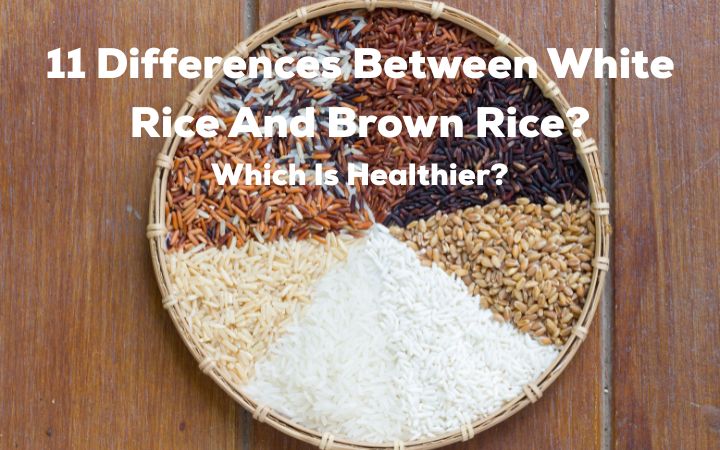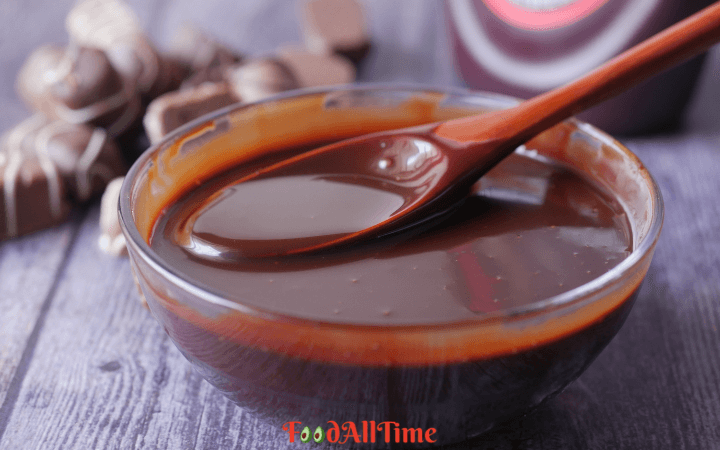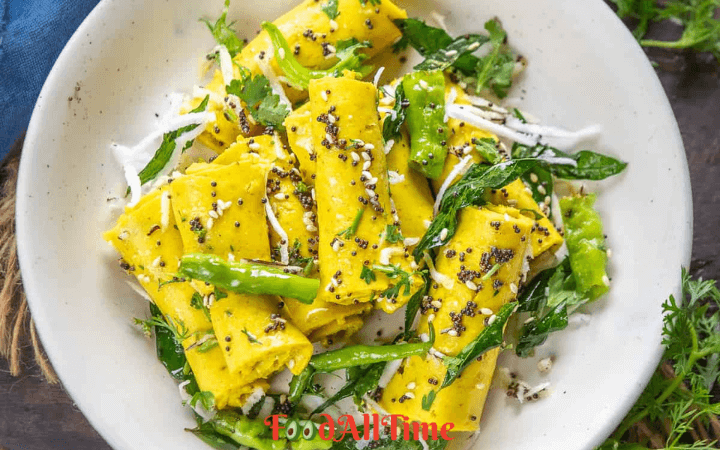11 Differences Between White Rice And Brown Rice: Which Is Healthier?
Since times unknown, Rice has been a staple food for millions of people worldwide. Whether it’s a comforting plate of biryani, a delicate sushi roll, or a simple bowl of steamed grains, rice plays a starring role in countless cuisines. But not all rice is the same.
The two most common types of rice, white rice and brown rice, are processed differently, have distinct tastes, and exhibit different health effects.
When it comes to choosing between eating white rice and brown rice, many people are unsure which is the healthier option or what makes them different in the first place.
In this article, we’ll take a deep dive into how white and brown rice differ in terms of processing, nutrition, taste, and health benefits. We’ll also explore which one may be better for you based on your health goals and lifestyle.
1. The Basic Difference: Processing and Structure

To understand how white rice and brown rice differ, you need to know how rice is processed in the mills. The basic difference between brown rice and white rice is how much of the grain’s natural parts are kept during milling.
- Brown Rice: This is a whole grain. When rice is harvested, each grain is covered by an inedible husk. Removing this husk leaves behind the edible grain, which still retains its bran (outer layer) and germ (nutrient-rich core). Brown rice is simply husked rice, with both bran and germ intact.
- White Rice: This is originally brown rice, which has been further milled and polished in factories. This removes the bran and germ, leaving mostly the starchy part, called the endosperm. This process gives white rice its smooth, polished look and softer texture. White rice appears polished, cooks faster, and has a softer texture. It also strips away much of the fiber, vitamins, and minerals.
In short: Brown rice = whole grain; White rice = refined grain.
2. Nutritional Profile: What’s Inside Your Grain
The milling process makes a big difference to the nutritional value.
Brown Rice (per 100g cooked)
- Calories: ~111
- Carbohydrates: ~23g
- Fiber: ~1.8g
- Protein: ~2.6g
- Fat: ~0.9g (healthy fats from the germ)
- Magnesium: ~44mg
- Phosphorus: ~83mg
- Manganese: High levels
- B vitamins: Thiamin, Niacin, and B6
- Antioxidants: Present in bran layer
White Rice (per 100g cooked)
- Calories: ~130
- Carbohydrates: ~28g
- Fiber: ~0.4g
- Protein: ~2.4g
- Fat: ~0.2g
- Magnesium: ~12mg
- Phosphorus: ~43mg
- Manganese: Lower levels
- Often fortified with iron and B vitamins (in some countries)
Key takeaway: Brown rice contains more fiber, vitamins, minerals, and antioxidants because it retains the bran and germ. White rice has fewer nutrients naturally but can be enriched during processing.
3. Fiber and Digestion

Fiber is one of the most significant differences between the two.
- Brown rice has about 4 times more fiber than white rice. Fiber helps regulate digestion, prevents constipation, and supports gut health.
- White rice is much lower in fiber, making it easier to digest — which can be beneficial for people with certain digestive issues or recovering from illness.
4. Blood Sugar Impact (Glycemic Index)
The glycemic index (GI) measures how quickly a food raises your blood sugar.
- Brown rice has a GI of about 50 (low to medium), meaning it causes a slower, steadier rise in blood sugar.
- White rice has a GI of about 73 (high), meaning it causes a quicker spike in blood sugar.
Why this matters: Eating it often, especially in large amounts, can increase the risk of type 2 diabetes. Brown rice is generally a better choice for people with diabetes, prediabetes, or insulin resistance, because it doesn’t spike blood sugar as rapidly.
5. Satiety and Weight Management
Brown rice is high in fiber so you feel full for longer. This helps with weight management by reducing the urge to overeat. White rice is filling in the short term but digests faster and may leave you feeling hungry sooner.
6. Antioxidants and Micronutrients

Brown rice’s bran layer is full of antioxidants. It has essential phenolic compounds as well, which fight against inflammation and prevent damage to cells. White rice loses all these antioxidants in the milling process.
Brown rice has more magnesium which helps with joint inflammation and nerve and muscle function and manganese which is good for bone health and metabolism.
7. Taste, Texture, and Cooking Time
Nutritionally, brown rice appears to be the clear winner, but taste and cooking preferences also play a significant role.
- Brown Rice: Has a nuttier flavor, chewier texture, and takes longer to cook (about 40–50 minutes). It also tends to be slightly denser. Some people prefer its earthy taste, while others may find it too heavy.
- White Rice: It is softer, cooks faster, and is easier to digest, which is why it is often chosen for children, older adults, or people with stomach troubles. It has a mild, neutral flavor, a softer texture, and cooks faster (about 15–20 minutes). It’s more versatile in recipes and tends to absorb flavors well.
Practical note: If you’re cooking for picky eaters or need quick meals, white rice may be a better fit for your routine.
8. Shelf Life and Storage
- Brown Rice: Because it contains the germ (which has oils), it can turn rancid more quickly. Shelf life is about 6 months at room temperature, though refrigeration or freezing can extend it.
- White Rice: Has a much longer shelf life (years) because it’s stripped of the oil-containing germ.
9. Health Considerations and Risks
Arsenic Levels
Rice has a tendency to easily accumulate arsenic from soil and water. In comparison to White rice, Brown rice tends to have slightly higher levels of arsenic because arsenic accumulates in the bran layer. While this is not usually a concern for moderate rice consumption, it’s good to:
- Rinse rice before cooking.
- Use extra water when boiling (like pasta) and drain it.
- Rotate rice with other grains, such as quinoa, millet, or barley.
Digestive Sensitivity
Brown rice contains more phytic acid, which can reduce mineral absorption in some people. While this is not a big concern for most healthy adults, people with digestive sensitivities might find white rice gentler.
10. Which is Healthier?

The healthiest choice depends on your taste, health needs, and how you prepare your meals. Remember: variety and balance are key to eating well. It largely depends on your health goals, lifestyle, and personal preferences.
- Choose Brown Rice if:
- You want more fiber for digestive health and satiety.
- You’re managing blood sugar levels.
- You’re aiming for more vitamins, minerals, and antioxidants.
- You don’t mind longer cooking times and a chewy texture.
- Choose White Rice if:
- You have digestive issues that make high-fiber foods uncomfortable for you.
- You’re recovering from illness and need an easily digestible carbohydrate.
- You want a softer texture for certain dishes (e.g., sushi, risotto).
- You need a long shelf-life pantry staple.
11. The Balanced Approach: Mixing or Rotating
You don’t necessarily have to pick just one type of rice for life. Many people enjoy mixing brown and white rice together for a balance of texture and nutrition. Others rotate rice with other whole grains like wild rice, quinoa, buckwheat, or bulgur for variety.
12. Cooking Tips for Maximum Nutrition
- Remember to rinse your rice at least 3 to 4 times before cooking to remove excess starch and some surface arsenic.
- Soak brown rice for a few hours to reduce cooking time and improve digestibility.
- Use low-sodium broth instead of water for extra flavor without adding unhealthy fats.
- Pair rice with vegetables, lean protein, and healthy fats for a balanced meal.
Conclusion
The main difference between white and brown rice lies in processing: brown rice is a whole grain with bran and germ intact, while white rice is refined and polished.
Nutritionally, brown rice has more fiber, vitamins, minerals, and antioxidants — making it the generally healthier choice for most people.
However, white rice still has its place in certain diets, especially when easy digestion, softer texture, and long shelf life are priorities.
Rather than labeling one as “good” and the other as “bad,” it’s better to view them as two different tools in your kitchen.
Both can be part of a healthy diet, but brown rice generally wins for its higher fibre and better effect on blood sugar.
If you love white rice, you don’t have to stop eating it, just watch your portions and balance it with vegetables and proteins.
Understanding their strengths lets you choose the one that fits your health needs, recipe requirements, and personal taste. After all, balance — not restriction — is the key to a healthy diet.
You Might Want To Try Some Rice Recipes
- Best Way To Cook Basmati Rice
- FoodallTime Easy Masala Basmati Rice Recipe
- Easy To Cook Flavoured Curd Rice Recipe
- Learn How To Cook Non-Vegan Fried Rice In Minutes!
- Healthy and Tasty Broccoli Rice Bowl: A Perfect Wholesome Meal
- Delicious Khajur and Rice Kheer Recipe
- Khichdi: The Comfort Food of India
- Sunday Recipe: Delicious Begun Bhaja
- How To Make A Bilahir Tok: Tomato Chutney in Assamese Style
- How to Prepare Bhoger Khichdi in Assamese Style
- Varan Bhaat: Maharashtrian Varan Bhaat Recipe
- Easy Aloo Bhaji Recipe | Batata Bhaji | Potato Bhaji
- Maharashtrian Style Masala Khichidi Recipe







